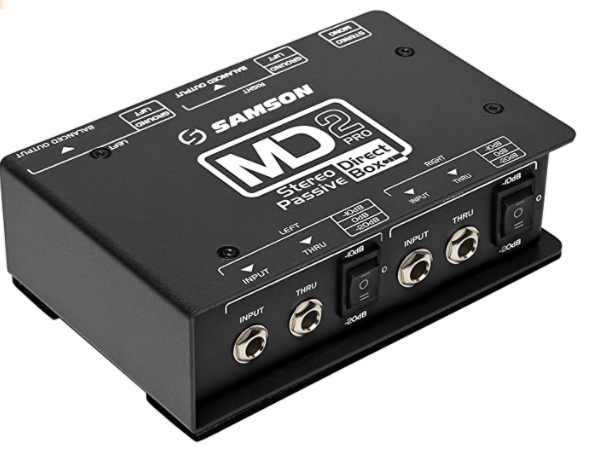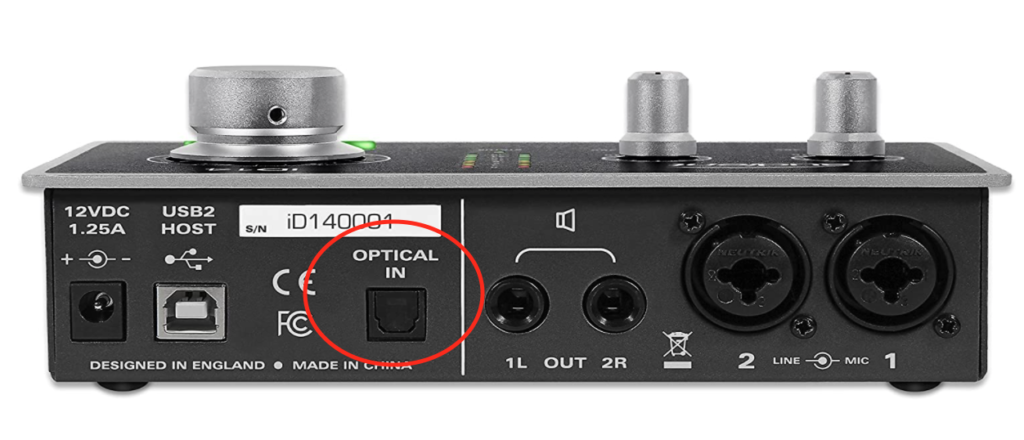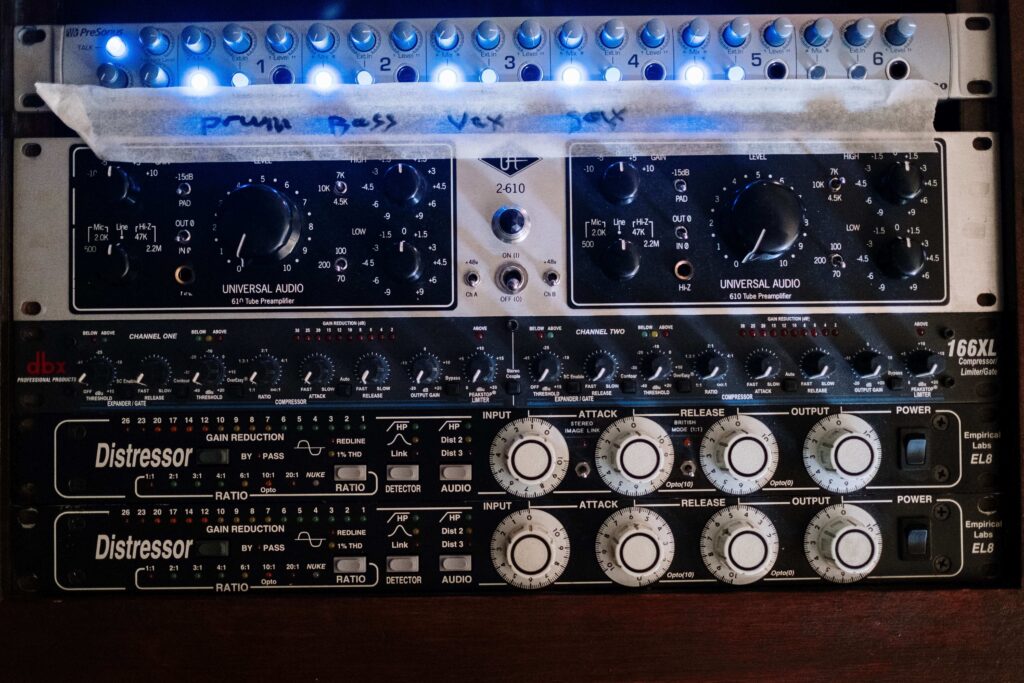Are you wondering how to connect your preamp to your audio interface?
Don’t know where to start?
Using an external preamp can help take your sound to another level.
Let’s discuss three ways to connect a preamp to an audio interface and the benefits of using one.
Overview
There are three simple ways to connect a preamp to an audio interface:
- Connect preamp output to audio interface input
- Through a Recording Digital Signal Direct Box
- Using ADAT Optical Inputs
Three Ways to Connect a Preamp to an Audio Interface
1. Connect Preamp Output to Audio Interface Line Input
If your audio interface has line inputs, connecting a preamp is simple.
You’ll generally see three types of inputs on an audio interface: mic level, instrument level, and line level.
Mic and instrument inputs have built-in preamps.
Why?
Mic and instrument signals are below line level – which is the proper level for recording.
A preamp adds gain to these signals to raise them to line level.
Connecting your preamp to one of these inputs is like amplifying a signal twice – which can cause distortion.
Instead, you’ll want to bypass your audio interface’s preamps.
Line Level Input
This is where line inputs come into play.
Line inputs are designed to receive signals that have already been amplified – at line level.
How to Connect
Some external preamps have 1/4-inch outputs.
In this case, you can connect it to an audio interface using a ¼ TRS cable.
For a preamp with XLR outputs, you can use an XLR female to TRS male jack connector.
Here’s how to connect everything step by step:
- Connect your microphone or guitar to your external preamp
- Connect line-out on your preamp to line-in on your interface using a TRS or XLR to TRS cable
- Plug your interface into your computer via USB
For some interfaces, like the Focusrite Scarlett 2i2, you can switch its 1/4-inch input between a line or instrument input.
If you’re using one of these inputs to connect your preamp, you want to make sure you have the line option selected.
Also, some entry-level interfaces – like the PreSonus AudioBox USB 96 -don’t have line inputs.
How do you connect an audio interface to a preamp in this case?
2. Connect Preamp to Audio Interface using a Direct Box

If your audio interface doesn’t have line inputs, you’ll need a direct box.
A direct box can convert the line-level signal from your preamp to a mic or instrument-level signal that your audio interface can receive.
However, this isn’t the most ideal way to connect a preamp.
You can find plenty of affordable interfaces with multiple line inputs.
[Learn more about Direct Boxes here]
3. Connect Preamp to Audio Interface through Optical ADAT

Some audio interfaces like the Audient iD14 and preamps like the Focusrite Clarett OctoPre have ADAT ports.
ADAT lets you expand the number of inputs on your audio device.
You’ll need an optical ADAT cable.
This cable lets you transmit audio signals digitally from your preamp to your audio interface.
Simply connect one end of the ADAT cable into your audio interface and the other into your preamp.
What’s the Purpose of a Preamp?
A preamp amplifies mic and instrument level signals.
Why is a preamp necessary?
When you sing into your microphone, its diaphragm receives small vibrations of sound waves from your voice.
Your mic converts sound waves into electrical signals and sends them to your audio interface.
Mic Level Signals
Since the diaphragm reacts to small vibrations, microphones naturally produce low-level signals.
Generally, mic signals will be less than around -20dB.
As a result, you’ll need a preamp to add gain to your signals.
Line Level Signals
Your preamp will boost them to the appropriate level for recording – around +4dBu.
We refer to this level as “line level.”
An example of a line-level instrument is a digital keyboard. You can connect one to your audio interface’s line inputs.
Conversely, mics and guitars produce signals below line level.
You’ll want to connect them through mic and instrument inputs for the best quality.
From there, the interface’s preamps will increase these signals to line level.
[Here are the audio interfaces with the best preamps]
Do all Audio Interfaces have Preamps?
Not at audio interfaces have preamps, but most do.
The preamps in audio interfaces are usually excellent quality for home studio recording.
Generally, the more expensive an audio interface is, the better its preamp will be.
However, there are plenty of interfaces below $250 with crystal-clear low-noise preamps.
Do you Need an External Mic Preamp if you have an Audio Interface?

Even though audio interfaces have preamps, there are different external preamps you can use in your studio.
We can categorize preamps based on their circuit design – tube, solid-state, and hybrid.
They also vary based on the sound they produce – transparent vs. colored.
Transparent Preamps
Transparent preamps add gain to your audio without changing its fundamental tone.
Solid-state preamps fall in this category.
They produce a clean sound with very little distortion, even at higher gain levels.
Most audio interfaces come with solid-state preamps.
Why Use a Transparent Preamp with an Audio Interface?
What are the benefits of using a transparent external preamp with an audio interface?
External preamps can produce better sound quality at higher gain levels than many audio interface preamps.
Most entry-level audio interfaces have a maximum gain threshold of less than 60dB.
Less than 60dB is fine for condenser mics, which require 30 – 50dB of gain to reach line level.
However, low output dynamic mics and ribbon mics can require up to 70dB.
External preamps can add additional gain without introducing unwanted noise and distortion into your signals.
Preamps that Add Color
Tube preamps are known to add color or warmth to recordings.
What does it mean to add warmth to a sound?
Warmth
When we refer to a preamp adding warmth to your recordings, it’s similar to applying a low-pass filter.
It reduces higher frequencies and boosts low-end frequencies to create a deeper bass tone.
This process is also referred to as thickening a sound.
Brightness
Conversely, adding brightness involves highlighting higher frequencies and reducing lower tones.
Some producers and engineers prefer preamps that accurately reproduce their original recordings.
But others enjoy the warm tone that a tube preamp adds.
Takeaway: How to Connect an External Preamp to an Audio Interface
Connecting a preamp to an audio interface is simple.
In most cases, you can connect your audio interface line inputs to your preamp outputs using a 1/4 TRS cable.








